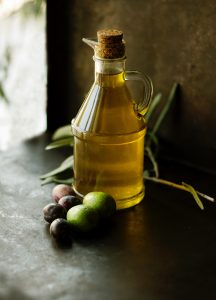 If you’re looking for the healthiest oil to use, and choosing from olive, avocado or coconut oil, you’ve narrowed your choices down to three very healthy options. All three are good oils to use and each has their own benefits and drawbacks. What it basically comes down to is your personal taste and making certain you get the oil that has the right type of processing in each group. For instance, choose extra virgin olive oil and extra virgin avocado oil that’s first pressed and cold processed. Coconut oil is removed from the meat of the coconut through a wet or dry technique. The wet method and first pressed is the healthiest coconut oil.
If you’re looking for the healthiest oil to use, and choosing from olive, avocado or coconut oil, you’ve narrowed your choices down to three very healthy options. All three are good oils to use and each has their own benefits and drawbacks. What it basically comes down to is your personal taste and making certain you get the oil that has the right type of processing in each group. For instance, choose extra virgin olive oil and extra virgin avocado oil that’s first pressed and cold processed. Coconut oil is removed from the meat of the coconut through a wet or dry technique. The wet method and first pressed is the healthiest coconut oil.
Olive oil and avocado oil are mostly monounsaturated fatty acids—MUFAs.
Monounsaturated fatty acids—MUFAs—are the most dominant type of fat in both olive and avocado oil. This type of fat is more stable when cooking, but has other health benefits, such as protecting the DNA, fueling the fires of the cell mitochondria and increasing the strength of cell walls. They improve and help regulate the immune system and are known for aiding in the prevention of breast cancer. MUFAs are also important for raising the good cholesterol—HDL, while preventing oxidation of bad cholesterol on vessel walls, causing blockage and lowering blood pressure, MUFAs improve blood glucose control and reduce insulin resistance, plus help burn body fat.
Coconut oil has a higher ratio of saturated fat to monounsaturated fat.
Coconut oil is about 90% saturated fat, compared to olive oil and avocado oil that’s 90% monounsaturated fat. It does, however, contain three fatty acids that are medium chain fatty acids, caprylic acid, lauric acid and capric acid. Those three medium chained saturated fatty acids make up 60% of the composition of coconut oil. Because the medium chained fatty acids—MCFAs—are easier to digest and metabolize, they provide quick energy and don’t store in the body, so they can enhance endurance. MCFAs enhance fat burning ability. Lauric acid and caprylic acid are antiviral, antifungal and antibacterial.
Are you using it for cooking or on salad?
When you cook with oil, there’s a point where the oil quits sizzling and starts to smoke. It’s called the smoke point but is really the burn point. When oil burns, it leaves an unhealthy residue. That smoke is an indication that the oil is breaking down and releasing chemicals to give the burnt flavor, while releasing free radicals. Coconut oil has a smoke point of approximately 350 degrees F. Extra-virgin olive oil is great for salads and stable for low to medium cooking temperatures between 350 and 400 degrees F, it breaks down if the temperature is hotter. Avocado is stable up to approximately 480 degrees F, so you can grill and fry with it.
- Caprylic acid and lauric acid have been shown to be effective in fighting disease-causing microorganisms, such as escherichia coli, staphylococcus aureas, streptococcus mutans and helicobacter pylori, the bacteria responsible for ulcers.
- Coconut oil helps protect the brain, due to the MDFAs. It helps people with epilepsy and those with Alzheimer’s by providing fuel for the brain that’s better than glucose. It’s also heart healthy and anti-inflammatory.
- If you’re baking food avocado oil may offer the best option, primarily due to the taste that olive oil can have and the fact that coconut oil can also impart a coconut flavor. It’s all a matter of personal preference.
- Avocado and olive oil enhance the antioxidants of garlic, onions, peppers and tomatoes and makes them more bioavailable. Coconut oil enhances omega 3 fatty acids and the absorption of calcium and magnesium.
For more information, contact us today at LIV Fitness
